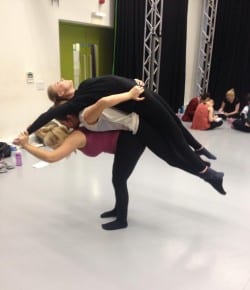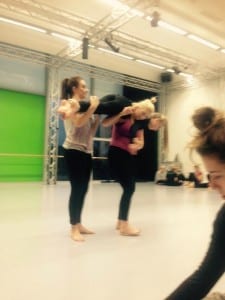This week’s aim was to experiment within a trio. I was in a group of five and our question was ‘Is it possible to do the same lifts with the same intention and fluidity in a trio as it is a duet’. Throughout contact improvisation we found that within a trio one person often became the outsider whilst the duet performed lifts. We wanted to experiment with a wide variety of lifts to see how we can incorporate a third person. We did not only want to perform the lifts, but find ways in which we could link them fluidly between our solo improvisations.
We went on to experiment with lifts we had learnt in previous workshops. Firstly, we tried to re-create the back to back lift, which created the image of a see-saw. We found this lift in particular fairly difficult. Having two people as a base instead of one and the other person leaning on two of our backs created an un-even surface. We found that one person was taller than the other so the surface for the over dancer was un even. Moving on from this we decided to try the lift again, however, placing two people on one person’s back. This worked more adequately, providing we had a strong and supportive base. The lift also appeared to be visually exciting and looked rather advanced. I will definitely try to incorporate this lift throughout improvisation.
Moving on, we experimented with a different lift, which in a duo requires the under dancer to lift the over dancer underneath the arms in order to create lift whilst moving backwards. From this, we incorporated a third person by having them as an under dancer and lifting at the over dancers ankles. This then created a T-shape position. Again, what we found is that it required the two under dances to be of a similar height in order for the lift to be successful, creating a symmetrical T shape. We then went on to trying to link into and out of the lift, to create fluidity and ease. Linking out of the lift was fairly more difficult, however, we found a sufficient movement which worked well. Sliding the over dancer along the under dancer’s shoulder added fluidity and grace to the lift.
We then went on to develop the hip to hip lift. From this we had the under dancer lift the over dancer higher than the hip in order to create height. Leading on from this a third person took the weight of the over dancer creating another lift from this. We found this particular lift fun to o experiment with as it gave us a lot of opportunities incorporating different levels and shapes. This lift added great fluidity and raised connections between each dancer as a trio.
Creating a small jam and showing our research we all participated within the jam looking for opportunities to create lifts as a trio. We found ourselves coming into a clump in order to initiate the lifts. This created chaos and made the jam look clunky and full of thought. After participating in this we discovered questions which would help us develop the research lab further.
- Can you interchange the role of the lifter who is being lifted?
- Can you pass on the weight of the lift from one person to another?
- Can you perform lifts in trios without grabbing or using the arms as a support?
- How can a trio lifts move across the floor and through space
We decided we would try to experiment with these particular questions throughout the Jam. Before the jam commenced i felt tired and effortless. However, i soon became surprised when i found out the jam was going to be blindfolded. This task was exciting, however, i was extremely cautious of that was to come. Commencing the jam i found everyone was being over cautious and not taking risks with the lifts. Nevertheless, we soon came into our comfort, almost forgetting the blindfold was there. I even found myself being comfortable improvising with everybody not knowing who they were. Afterwards, i discovered i worked very well with robin incorporating a range of lifts fluidly. This has enable to be more confident, as it has proven to me that i can work with several people and take more risks.

![IMG_6870[1]](https://ellieosullivancontactimprov.blogs.lincoln.ac.uk/files/2014/11/IMG_68701-225x300.jpg)
